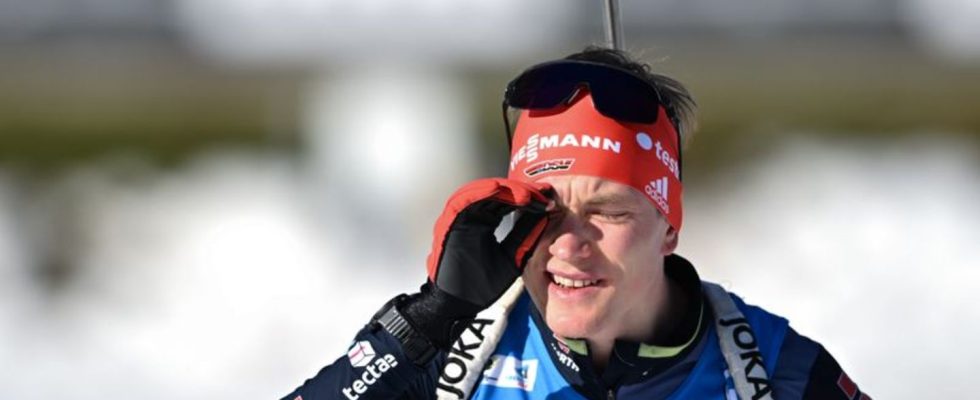Start of the season
The German biathlon plan: More risk for more medals
Benedikt Doll is the great hope of the German biathlon men. photo
© Hendrik Schmidt/dpa
The German team is starting the new winter in Sweden without the most successful biathlete in recent memory. The competition seems overwhelming, but there is also reason for hope.
After the end of Olympic champion Denise Herrmann-Wick’s career and the retirement of long-time head coach Mark Kirchner, a World Cup season begins on Saturday (12.30 p.m./ARD and Eurosport) with the mixed competitions in Östersund, Sweden, before which there are still a few unanswered questions.
“We hope that everyone will take a step forward,” Velepec said. The 56-year-old Slovenian was Kirchner’s assistant until spring. After more than a decade in a responsible position, the Thuringian retired and looks after the young talent. “The pressure is greater now,” said Velepec. Because his athletes are expected to continue to achieve success in Germany’s favorite TV winter sport.
Most successful athlete no longer there
However, Herrmann-Wick from Saxony is missing the most successful athlete, who recently hid a lot with her victories and medals. “A protective shield is now gone, Denise achieved that through performance,” said sports director Felix Bitterling: “This is now an opportunity for new faces.”
However, the situation for men and women is very different. While among the men, apart from former world champion Benedikt Doll (33), nobody seems to be able to keep up with the overwhelming Norwegians around long-time winner Johannes Thingnes Bö and pursuer Sturla Holm Laegreid, a women’s team with many hopefuls is growing up. But they don’t yet seem to have advanced enough to compete permanently against stars like Elvira and Hanna Öberg (Sweden), Lisa Vittozzi (Italy) or Julia Simon (France). “For the women, I’m not worried at all about 2026,” said Bitterling anyway.
And 2026 is the big goal. Medals are definitely needed at the Olympic Games in Italy’s biathlon mecca Antholz. That’s why there were long training camps at altitude for the first time in preparation. “We need more data from above,” Velepec said. If the World Cup takes place in February 2024 in the lowlands of Nove Mesto/Czech Republic, it will then go to the World Cup altitude of Lenzerheide in Switzerland in 2025 and finally again at a good 1500 meters to South Tyrol, where the Olympic medals will be awarded in Antholz.
Doll with a good feeling
“We were in a lot of new places and did a lot of different units,” said the Black Forester Doll: “I have a good feeling. The most important thing for us is consistently good shooting performance.” If he regularly hits 90 percent of the targets and runs like in previous years, “there could be some podium places,” said Doll, who will probably retire after the winter. In the spring he won over 20 kilometers in Östersund, and this competition is on Sunday as the first individual discipline of the season.
Who else is capable of top results? The women have many hopes for the returnee Franziska Preuß. The 29-year-old Bavarian had to end last season early in January and was recovering from health problems. When she returned, she won all three titles at the German rollerski championships. If she stays healthy, she could become the new leader. In addition, Vanessa Voigt (26), Sophia Schneider (26) and Hanna Kebinger (25) are able to attack at points. Selina Grotian is also given a lot of credit. The 19-year-old from Garmisch-Partenkirchen became four-time junior world champion in the spring and is considered the greatest talent.
There is a lack of such young hopefuls among men; there are no top talents around the age of 20. Johannes Kühn (32), Roman Rees and Philipp Nawrath (both 30) are significantly older. “It’s really a shark tank, but we want to introduce the young ones,” Bitterling said. The competition at the top of the world is fierce. As in the previous season, the Norwegians again have a whole squad that can win victories among themselves. At their own season opener almost two weeks ago, they outclassed the international competition.
Fluorine wax ban
Apparently they also benefit from the ban on fluorine wax when preparing skis. With the beginning of winter, this ban also applies to biathletes, as an EU directive banning certain fluorine compounds is being implemented. They are considered harmful to the environment and health, but they make the skis fast. The Norwegians did a lot of tinkering and apologized after the test races for their blatant material advantages. It will be exciting to see whether and how quickly the competition can catch up in this area.
An important step for better running performance for the Germans was the signing of Jens Filbrich. The former world-class cross-country skier from Thuringia is responsible for running training and would like to promote improvements. The shooting times were also fine-tuned in the summer. “We just need too long for the first shot,” said Bitterling. The Norwegians around Bö act much more aggressively and uncompromisingly with the weapon, sometimes risking making a mistake. Doll and Co. should focus more on this in the future.

